|
Friday, April 7, 2006, 5:25 pm
Hello from Cuernavaca - Opening a South
African Photo Exhibition and a Visit to the Palacio Cortes
After my visit of the Newcomers Club
I took a taxi to the Museo de la Ciuadad which is located directly
about the Tourist Office of the City of Cuernavaca. There I connected
with some colleagues from the Ideal
Language School where I had been taking language classes this
past week.
The Museum of the City was the location of the ribbon-cutting ceremony
for a special exhibition by two South African photo journalists,
Dr. Peter Magubane and Omar Badsha. The photo exhibition was appropriately
called Dos Lentes - Dos Visiones - Una Experiencia, "Two
Lenses - Two Visions - One Experience".

Hand-painted poster for the exhibition
Dr. Peter Magubane was born in a suburb of Johannesburg and found
himself drawn to photography early on. He was inspired by the photographers
of Drum Magazine and started his work in 1955 with his
first job covering the convention of the African National Congress.
In 1958 he was the first black person to receive a photography prize
in the country. He was arrested in 1969 while covering the protests
outside of Winnie Mandela's prison cell and was prohibited from
practicing his profession for the next 5 years.
Dr. Magubane is an independent South African reporter and photojournalist
whose credits include UNICEF and the United Nations High Commission
for Refugees. He is the only black South African photographer who
was able to enter and document the events in other African countries
such as Ethiopia, Mozambique, Somalia, Zambia and Zimbabwe. He also
worked as a photographer for the Rand Daily Mail. He gained international
recognition during the June 16, 1976 uprising and won various prizes
in the fields of photography and jouralism.
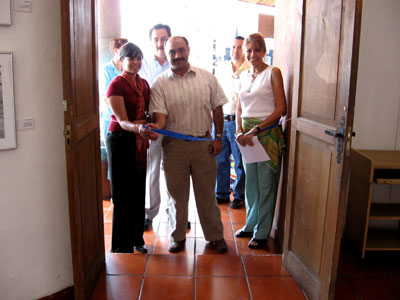
The official ribbon-cutting ceremony begins
Omar Badsha was born in 1945 as part of a Muslim Gujarati family.
His grand-parents had emigrated from India to South Africa towards
the end of the 1890s. Badsha is a celebrated artist and self-taught
photographer and played a very important role in the South African
fight for human rights. During the 1970s he was part of small, but
select group of union activists and in 1987 he and his family moved
to Cape Town to create the "Center of Documentary Photography"
at the University of Cape Town.
He is one of the founding members of the Cultural Workers Congress
and was also a key member of the legendary independent agency and
photographers collective called Afrapix. This agency played
a critical role during the 1980s in documenting the fight against
apartheid. Currently Omar Badsha is working on a retrospective exhibition
and educational project about the history of South Africa.
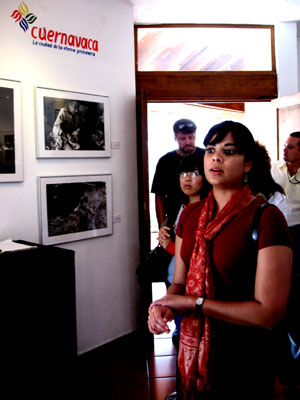
Pooveshnee Reddy from the South African embassy explains some of
the photos
A woman by the name of Pooveshnee Reddy from the South African
embassy came out to introduce the exhition. She cut the ribbon and
gave us some background on the exhibition. The photos were very
gripping, images of apartheid, racial segregation, a young black
boy - dead and covered by a newspaper, a photo collage consisting
of a poor black shantytown and an upscale neighbourhood just blocks
away really gave us a taste of what apartheid must have been like.
But there were also images of celebration, when apartheid came down,
and an image of a boy jumping through the air. A reminder that sometimes
the happiest moments can be experienced by the people who have the
least.....
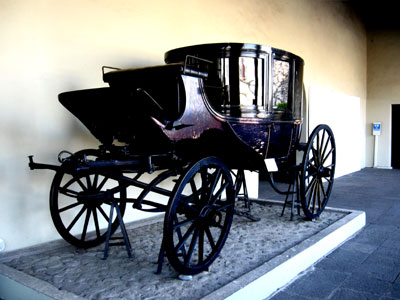
Carriage on display in the Palacio de Cortes
After this stirring photographic exhibit I took the bus downtown,
where I exited at the Zócalo and ate in a little local restaurant
for $5. Then at 3 pm I headed to the Palacio de Cortés for
a guided tour together with 3 members of a music quartet from Prague
(Czech Republic) who were in town for a concert tonight.
The Palacio de Cortés is a former residence of Mexican's
conquistador, Hernán Cortés, who invaded the country
in 1519 and in three short years had conquered it and along with
it destroyed the Aztec empire of Moctezuma. With his palace he left
a lasting legacy in Cuernavaca, which was originally called
Cuahnahuac ("Place of great trees") by the local
Tlahuica Indians. The Spaniards renamed it Cuernavaca ("Cow's
horn") since that was easier to pronounce.
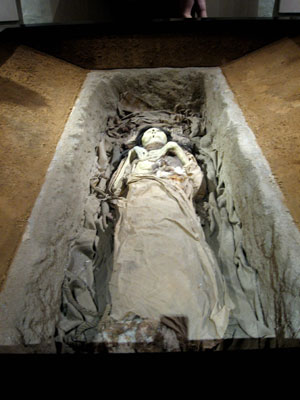
Mummy in the Cuahnahuac Museum
The Palacio de Cortés is also called the Museo de Cuahnahuac
and is located on the southeast side of Cuernavaca's Plaza de Armas.
Cortés began building the structure in 1526 and lived in
the palace for several years until he returned to Spain in 1540,
never to set foot in Mexico again.
The building was later used as a prison, a Catholic Church and
also as the seat of the Morelos State Legislature. The building's
salons display a variety of pre-Hispanic and colonial artefacts
including carriages, furniture, farm implements, even a suit of
armor. One of the exhibition rooms holds a Indian mummy in an open
casket, well-preserved and a somewhat eerie sight. On the top floor
there is also an arched gallery holding one of muralist Diego Rivera's most renowned works: the mural Historia de Morelos, Conquista
y Revolución ("History of Morelos, Conquest and
Revolution") which is intended too summarize the history of
the State of Morelos.
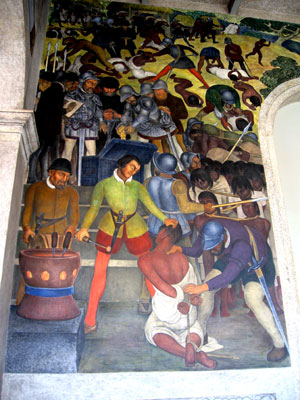
Diego Rivera mural in the Palacio de Cortés
After this historical education, I went to an Internet café,
and finally took a bus to the Plan de Ayala residential area where
I picked up my orthotic inserts to help me with my inflamed ankle.
The ability to walk is crucial for a travel writer/ photographer
like me, so I am hoping that these orthopedic inserts will do the
trick. Right across the street I went into a supermarket and bought
some bananas, mangoes, a bottle of pop, Doritos, and went back to
my comfortable accommodation at La Nuestra.
By 7:30 pm I had arrived, taken off my shoes and was relaxing by
the pool, listening to the wonderful song of tropical birds.
I read a little but I was physically exhausted. The last few days
have been a whirlwind of experiences and I definitely need a bit
of downtime. I think I am going to sleep a bit before I write up
today's stories...
Useful Books:
Related Articles:
Mexico 2006 - My cultural immersion
experiment
Hello from Mexico City - First impressions
Hello from Mexico City - A skyscraper,
a little horse and a government pawn shop
Hello from Mexico City - The Zócalo,
the Cathedral, a healing ritual and a university dedicated to a
16th century female poet
Hello from Mexico City - A relaxing
evening in Coyoacán
Hello from Mexico City - Exploring the
Paseo de la Reforma, de Bosque de Chapúltepec and a nice
evening in San Angel
Hello from Cuernavaca - Arrival and
first impressions
Hello from Cuernavaca - Getting to know
my B&B hostess Marta Elena: A true riches to rags story
Hello from Cuernavaca - My first day
learning Spanish and two local icons: the Robert Brady Museum and
the Jardín Borda
Hello from Cuernavaca - A lovely dinner
in a garden paradise
Hello from Cuernavaca - An excursion
to Las Estacas, checking out orchids and a meeting at El Cafecito
Hello from Cuernavaca - An excursion
to Lake Tequesquitengo and a visit to the doctor
Hello from Cuernavaca - A conversation
with Andy Grater, local B&B owner and President of the Newcomers
Club
Hello from Cuernavaca - A presentation
about ecology at the Newcomers Club Meeting
Hello from Cuernavaca - Opening of a
South African photo exhibition and a visit to the Palacio de Cortés
Hello from Taxco - The city that silver built
Hello from Taxco during Semana Santa - The
famous Palm Sunday Procession
Hello from Cuernavaca - A new language
school, visiting 'Casa Vamos' and an evening with a very sad ending
Hello from Cuernavaca - My most intense
day: more language studies, 3 interviews, a guided eco-hike and
dinner at the Marco Polo
Hello from Cuernavaca - A day outing
to the enchanting mythical village of Tepoztlan
Hello from Cuernavaca - My last day
of school and a visit to Cuernavaca's Spring Fair
Hello from Taxco - An eerie experience: Visiting
Taxco's famous Good Friday procession
Hello from Taxco and Cuernavaca - Interviewing
one of the penitentes and enjoying my last day in Mexico
Related Interviews:
Presenting:
Ruben Córtes from Morelos Trails - Local adventure sports
and cultural guided tour operator, expert on Morelos and Cuernavaca
Presenting: Pablo
Buitrón from Fundacion Comunidad, helping local
women empower themselves
Presenting: Jorge Torres from
the Cetlalic Alternative Language School - Learning Spanish with
cultural, social and political awareness
Presenting: Hermilo Brito
from the Ideal Language School - Making Spanish learning fun
Helpful links:
Mexico
Tourism Information
State
of Morelos Tourism Organization
Official
website of the City of Cuernavaca tourism
|